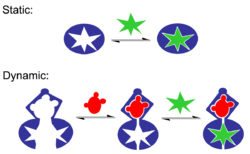Reconhecimento molecular
O termo reconhecimento molecular se refere à interação específica entre duas ou mais moléculas por meio de ligações não covalentes, como ligações de hidrogênio, coordenação de metal, forças hidrofóbicas,[3][4] forças de Van der Waals, interações π-π, ligações de halogênio ou efeitos de interação ressonante.[5] Além dessas interações diretas, os solventes podem desempenhar um papel indireto dominante na condução do reconhecimento molecular em solução.[6][7] O hospedeiro e convidado envolvidos no reconhecimento molecular exibem complementaridade molecular. As exceções são recipientes moleculares,[8][9] incluindo, por exemplo, nanotubos, nos quais os portais essencialmente controlam a seletividade.[10][11][12][13]



Sistemas biológicos
editarO reconhecimento molecular desempenha um papel importante nos sistemas biológicos e é observado entre receptor-ligante,[3][4] antígeno-anticorpo, DNA-proteína, açúcar-lectina, RNA-ribossomo, etc. Um exemplo importante de reconhecimento molecular é o antibiótico vancomicina que se liga seletivamente aos peptídeos com terminal D-alanil-D-alanina em células bacterianas através de cinco ligações de hidrogênio. A vancomicina é letal para as bactérias, uma vez que, depois de se ligar a esses peptídeos específicos, eles não podem ser usados para construir a parede celular da bactéria
Referências
- ↑ Knox, James R.; Pratt, R. F. (julho de 1990). «Different modes of vancomycin and D-alanyl-D-alanine peptidase binding to cell wall peptide and a possible role for the vancomycin resistance protein» (Free full text). Antimicrobial Agents and Chemotherapy. 34 (7): 1342–7. PMC 175978 . PMID 2386365. doi:10.1128/AAC.34.7.1342
- ↑ Bielawski, Christopher; Chen, Yuan-Shek; Zhang, Peng; Prest, Peggy-Jean; Moore, Jeffrey S. (1998). «A modular approach to constructing multi-site receptors for isophthalic acid». Chemical Communications (12): 1313–4. doi:10.1039/a707262g
- ↑ a b Lockett, M. R.; Lange, H.; Breiten, B.; Heroux, A.; Sherman, W.; Rappoport, D.; Yau, P. O.; Snyder, P. W.; Whitesides, G. M. (2003). «The Binding of Benzoarylsulfonamide Ligands to Human Carbonic Anhydrase is Insensitive to Formal Fluorination of the Ligand». Angew. Chem. Int. Ed. 52 (30): 7714–7717. PMID 23788494. doi:10.1002/anie.201301813
- ↑ a b Breiten, B.; Lockett, M. R.; Sherman, W.; Fujita, S.; Al-Sayah, M.; Lange, H.; Bowers, C. M.; Heroux, A.; Krilov, G.; Whitesides, G. M. (2013). «Water Networks Contribute to Enthalpy/Entropy Compensation in Protein–Ligand Binding». J. Am. Chem. Soc. 135 (41): 15579–15584. CiteSeerX 10.1.1.646.8648 . PMID 24044696. doi:10.1021/ja4075776
- ↑ Cosic, I (1994). «Macromolecular bioactivity: is it resonant interaction between macromolecules?—theory and applications». IEEE Transactions on Bio-Medical Engineering. 41 (12): 1101–14. PMID 7851912. doi:10.1109/10.335859
- ↑ Baron, Riccardo; Setny, Piotr; McCammon, J. Andrew (2010). «Water in Cavity-Ligand Recognition». Journal of the American Chemical Society. 132 (34): 12091–12097. PMC 2933114 . PMID 20695475. doi:10.1021/ja1050082
- ↑ Baron, Riccardo; McCammon, J. Andrew (2013). «Molecular Recognition and Ligand Binding». Annual Review of Physical Chemistry. 64: 151–175. Bibcode:2013ARPC...64..151B. PMID 23473376. doi:10.1146/annurev-physchem-040412-110047
- ↑ Cram, D. J.; Cram, J. M. Container molecules and their guests; Royal Society of Chemistry: Cambridge, 1997. ISBN 0851869726
- ↑ Brotin, Thierry; Dutasta, Jean-Pierre (2009). «Cryptophanes and Their Complexes—Present and Future». Chemical Reviews. 109 (1): 88–130. PMID 19086781. doi:10.1021/cr0680437
- ↑ Lehn, Jean-Marie (1995). Supramolecular Chemistry. Weinheim: Wiley-VCH. ISBN 978-3-527-29312-4. OCLC 315928178[falta página]
- ↑ Gellman, Samuel H. (1997). «Introduction: Molecular Recognition». Chemical Reviews. 97 (5): 1231–1232. PMID 11851448. doi:10.1021/cr970328j
- ↑ Dipankar Chatterji , Basics of Molecular Recognition , CRC Press; 2016, ISBN 1482219689
- ↑ Molecular Recognition and Polymers: Control of Polymer Structure and Self-Assembly V. Rotello , S. Thayumanavan, Eds. Wiley ,2008 ISBN 0470277386